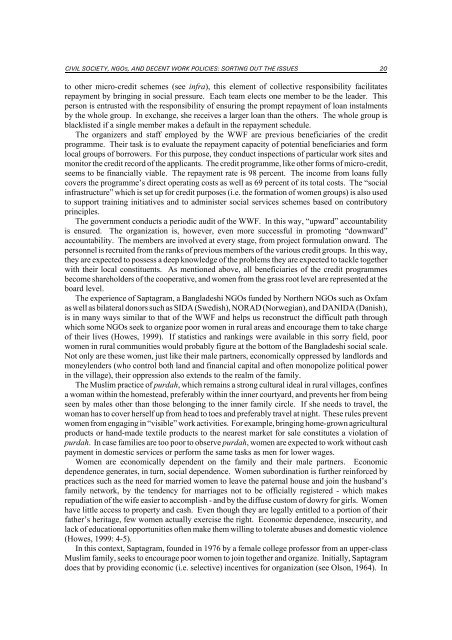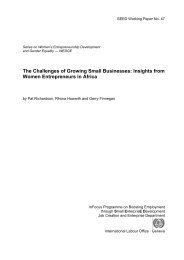Civil Society, NGOs, and Decent Work Policies: Sorting out the Issues
Civil Society, NGOs, and Decent Work Policies: Sorting out the Issues
Civil Society, NGOs, and Decent Work Policies: Sorting out the Issues
Create successful ePaper yourself
Turn your PDF publications into a flip-book with our unique Google optimized e-Paper software.
CIVIL SOCIETY, NGOS, AND DECENT WORK POLICIES: SORTING OUT THE ISSUES 20<br />
to o<strong>the</strong>r micro-credit schemes (see infra), this element of collective responsibility facilitates<br />
repayment by bringing in social pressure. Each team elects one member to be <strong>the</strong> leader. This<br />
person is entrusted with <strong>the</strong> responsibility of ensuring <strong>the</strong> prompt repayment of loan instalments<br />
by <strong>the</strong> whole group. In exchange, she receives a larger loan than <strong>the</strong> o<strong>the</strong>rs. The whole group is<br />
blacklisted if a single member makes a default in <strong>the</strong> repayment schedule.<br />
The organizers <strong>and</strong> staff employed by <strong>the</strong> WWF are previous beneficiaries of <strong>the</strong> credit<br />
programme. Their task is to evaluate <strong>the</strong> repayment capacity of potential beneficiaries <strong>and</strong> form<br />
local groups of borrowers. For this purpose, <strong>the</strong>y conduct inspections of particular work sites <strong>and</strong><br />
monitor <strong>the</strong> credit record of <strong>the</strong> applicants. The credit programme, like o<strong>the</strong>r forms of micro-credit,<br />
seems to be financially viable. The repayment rate is 98 percent. The income from loans fully<br />
covers <strong>the</strong> programme’s direct operating costs as well as 69 percent of its total costs. The “social<br />
infrastructure” which is set up for credit purposes (i.e. <strong>the</strong> formation of women groups) is also used<br />
to support training initiatives <strong>and</strong> to administer social services schemes based on contributory<br />
principles.<br />
The government conducts a periodic audit of <strong>the</strong> WWF. In this way, “upward” accountability<br />
is ensured. The organization is, however, even more successful in promoting “downward”<br />
accountability. The members are involved at every stage, from project formulation onward. The<br />
personnel is recruited from <strong>the</strong> ranks of previous members of <strong>the</strong> various credit groups. In this way,<br />
<strong>the</strong>y are expected to possess a deep knowledge of <strong>the</strong> problems <strong>the</strong>y are expected to tackle toge<strong>the</strong>r<br />
with <strong>the</strong>ir local constituents. As mentioned above, all beneficiaries of <strong>the</strong> credit programmes<br />
become shareholders of <strong>the</strong> cooperative, <strong>and</strong> women from <strong>the</strong> grass root level are represented at <strong>the</strong><br />
board level.<br />
The experience of Saptagram, a Bangladeshi <strong>NGOs</strong> funded by Nor<strong>the</strong>rn <strong>NGOs</strong> such as Oxfam<br />
as well as bilateral donors such as SIDA (Swedish), NORAD (Norwegian), <strong>and</strong> DANIDA (Danish),<br />
is in many ways similar to that of <strong>the</strong> WWF <strong>and</strong> helps us reconstruct <strong>the</strong> difficult path through<br />
which some <strong>NGOs</strong> seek to organize poor women in rural areas <strong>and</strong> encourage <strong>the</strong>m to take charge<br />
of <strong>the</strong>ir lives (Howes, 1999). If statistics <strong>and</strong> rankings were available in this sorry field, poor<br />
women in rural communities would probably figure at <strong>the</strong> bottom of <strong>the</strong> Bangladeshi social scale.<br />
Not only are <strong>the</strong>se women, just like <strong>the</strong>ir male partners, economically oppressed by l<strong>and</strong>lords <strong>and</strong><br />
moneylenders (who control both l<strong>and</strong> <strong>and</strong> financial capital <strong>and</strong> often monopolize political power<br />
in <strong>the</strong> village), <strong>the</strong>ir oppression also extends to <strong>the</strong> realm of <strong>the</strong> family.<br />
The Muslim practice of purdah, which remains a strong cultural ideal in rural villages, confines<br />
a woman within <strong>the</strong> homestead, preferably within <strong>the</strong> inner courtyard, <strong>and</strong> prevents her from being<br />
seen by males o<strong>the</strong>r than those belonging to <strong>the</strong> inner family circle. If she needs to travel, <strong>the</strong><br />
woman has to cover herself up from head to toes <strong>and</strong> preferably travel at night. These rules prevent<br />
women from engaging in “visible” work activities. For example, bringing home-grown agricultural<br />
products or h<strong>and</strong>-made textile products to <strong>the</strong> nearest market for sale constitutes a violation of<br />
purdah. In case families are too poor to observe purdah, women are expected to work with<strong>out</strong> cash<br />
payment in domestic services or perform <strong>the</strong> same tasks as men for lower wages.<br />
Women are economically dependent on <strong>the</strong> family <strong>and</strong> <strong>the</strong>ir male partners. Economic<br />
dependence generates, in turn, social dependence. Women subordination is fur<strong>the</strong>r reinforced by<br />
practices such as <strong>the</strong> need for married women to leave <strong>the</strong> paternal house <strong>and</strong> join <strong>the</strong> husb<strong>and</strong>’s<br />
family network, by <strong>the</strong> tendency for marriages not to be officially registered - which makes<br />
repudiation of <strong>the</strong> wife easier to accomplish - <strong>and</strong> by <strong>the</strong> diffuse custom of dowry for girls. Women<br />
have little access to property <strong>and</strong> cash. Even though <strong>the</strong>y are legally entitled to a portion of <strong>the</strong>ir<br />
fa<strong>the</strong>r’s heritage, few women actually exercise <strong>the</strong> right. Economic dependence, insecurity, <strong>and</strong><br />
lack of educational opportunities often make <strong>the</strong>m willing to tolerate abuses <strong>and</strong> domestic violence<br />
(Howes, 1999: 4-5).<br />
In this context, Saptagram, founded in 1976 by a female college professor from an upper-class<br />
Muslim family, seeks to encourage poor women to join toge<strong>the</strong>r <strong>and</strong> organize. Initially, Saptagram<br />
does that by providing economic (i.e. selective) incentives for organization (see Olson, 1964). In
















